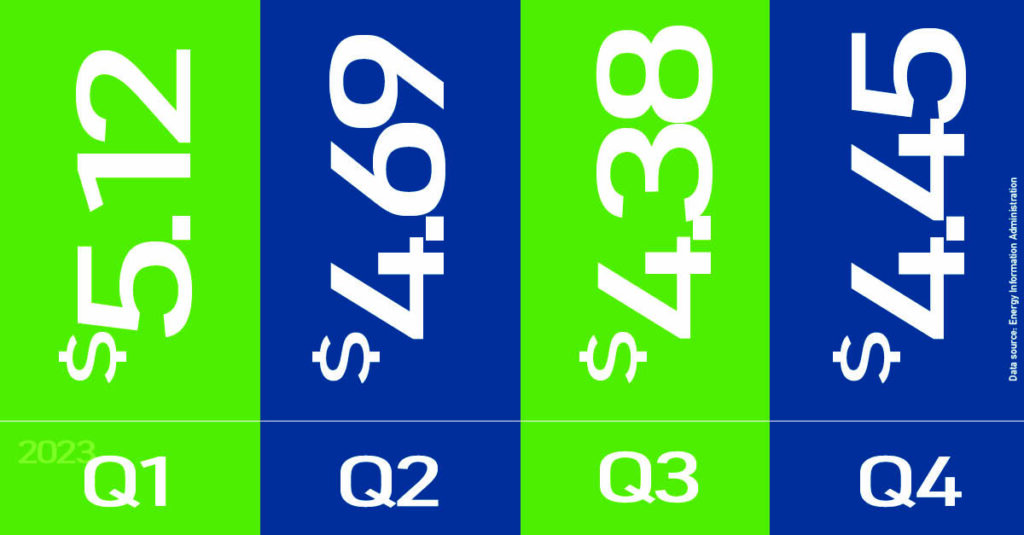The days of low diesel rates are gone. At least for the foreseeable future.
Fuel rates are high and diesel prices are projected to remain above $5 per gallon into the early months of 2023. Specifically, EIA projects diesel to average $5.12 per gallon in the first quarter of 2023, $4.69 in the second quarter, $4.38 in the third quarter and $4.45 in the fourth quarter.

You’ve surely felt the pinch. Diesel costs have been on the rise for a while now. In September 2022 diesel fuel was up 50.7% from 2021, which was already up 38.1% from 2020.
Shipping rates continue to fluctuate, working to keep up with shifting fuels costs and varying demand.
Switch up customer ordering patterns
It’s common for retail customers to order only a handful of cases at a time, often without meeting the shipping minimums set by your LTL providers. This requires shippers to send just one to two cases on a pallet, only to subsequently ship another small order a week later. Hardly efficient, and often unprofitable, but necessary for on-time and undamaged delivery.
Shipping minimums, or base prices, are set by LTL providers to ensure they can move your orders profitably. They set a price that no order can go below. So you might only need to move two cases projected at $50 profit, but the base rate is $100. You could lose money by fulfilling the order.
Don’t accept this as status quo. Work with your transportation partners to understand their shipping minimums so you can best negotiate minimum order quantities (MOQs) with your retail customers. With larger order sizes and reduced shipment frequency you can reduce fuel consumption.
And don’t neglect to check added fees. How are demands such as, after-hours delivery, Monday morning delivery, or a last-minute freight tender, really impacting spend? When you identify an overly costly element, talk with your sales staff and your customers. Establish order minimums based on location, request different delivery dates, and expanded lead times.
Retailers want you to deliver on time and in full. They also want you to be profitable. If you’re not, they can’t sell your product. Buyers are typically willing to discuss approaches that make shipping more feasible for their suppliers. Come prepared to the conversation with accurate data, a proposed solution, and examples of how each party benefits.
Shipping rates continue to fluctuate, working to keep up with shifting fuels costs and varying demand.
Create consolidation opportunities – inbound and outbound
When a new purchase order comes in, your warehouse likely preps and sends the product as soon as possible. While seemingly efficient, this reactionary approach can equate to extra costs.
Instead, work to understand your freight mix, inventory levels, customers, and production facilities. By looking wholistically at your orders, you can facilitate consolidation of shipments, both inbound and outbound. Coordinating multi-drop orders or shared assets means fewer miles and lower costs.
Maybe a new retail customer orders cases, not pallets. Not wanting to lose the larger sales potential, you send the cases via less-than-truckload and incur costs exceeding profit. Instead, look at your existing delivery footprints. Is there a regular delivery within 100 miles of the new customer? You could add the new pallet order to an existing lane and save on transportation costs.
Comparable to a mega game of Tetris, focusing on consolidation can feel overwhelming and utterly confusing. Tools like FST’s InSight make the identification of opportunities simpler.
Building a consolidation strategy requires full visibility. Involve transportation, sales, and production to find where efficiencies may be hiding.
Find fuel cost savings while strengthening partnerships
Data from Technical Traffic Consultants shows that contracted rates are down 6% from June 2022 because of increased capacity. Additionally, rebids are trending 8% to 15% lower as compared to last year. And there are significant savings year over year on spot rates, which are down 15%.
Should you go out to bid or try the spot market? Short answer: Yes. Now is a great time to find savings. It’s also a great time to solidify partner relationships.
We recommend that shippers take advantage of lower shipping rates, but don’t rely on the lowest cost provider. Freight markets are cyclical. Which means, capacity is going to be tight again. Shippers who jump back and forth from one low-cost provider to another will find the eventual market shift difficult to manage.
As capacity tightens, transportation rates will increase. If too much of your freight mix is subject to the spot market, you’ll quickly lose any savings gained during the softer period.
Maintain relationships with asset providers and trusted owner-operators. With a true partnership in place, you can take advantage of cheaper rates during a soft market while still holding on to essential capacity.
Managing Rising Fuel Costs in a Soft Market
Even as fuel costs rise, there are savings to be found in your supply chain. Have honest conversations with your logistics partners about price shifts that match the current market. And try switching up shipping patterns to find new efficiencies.
With more visibility into your freight mix and flexibility with customer orders, you can find new ways to save that will benefit you in the year ahead.


